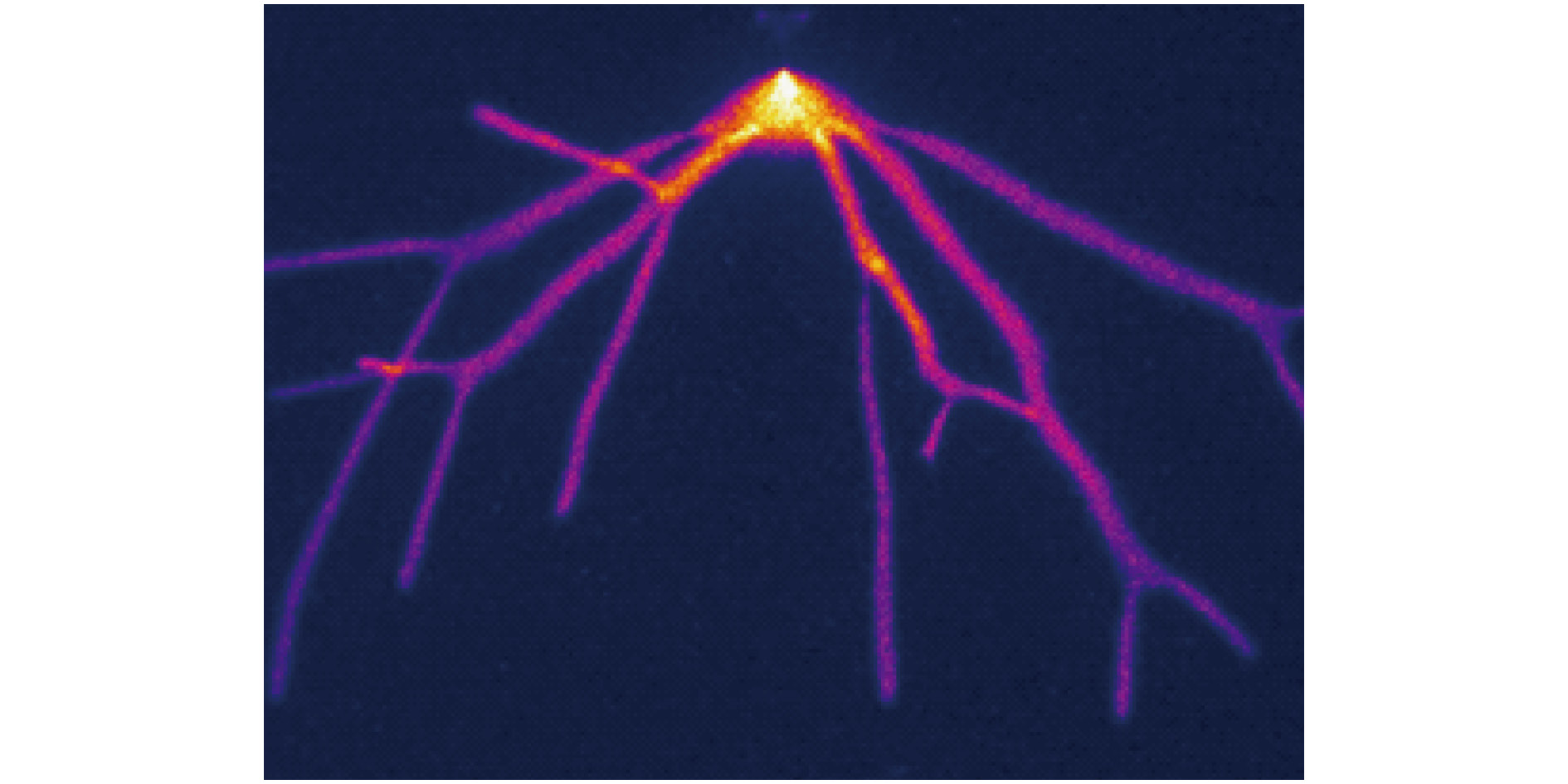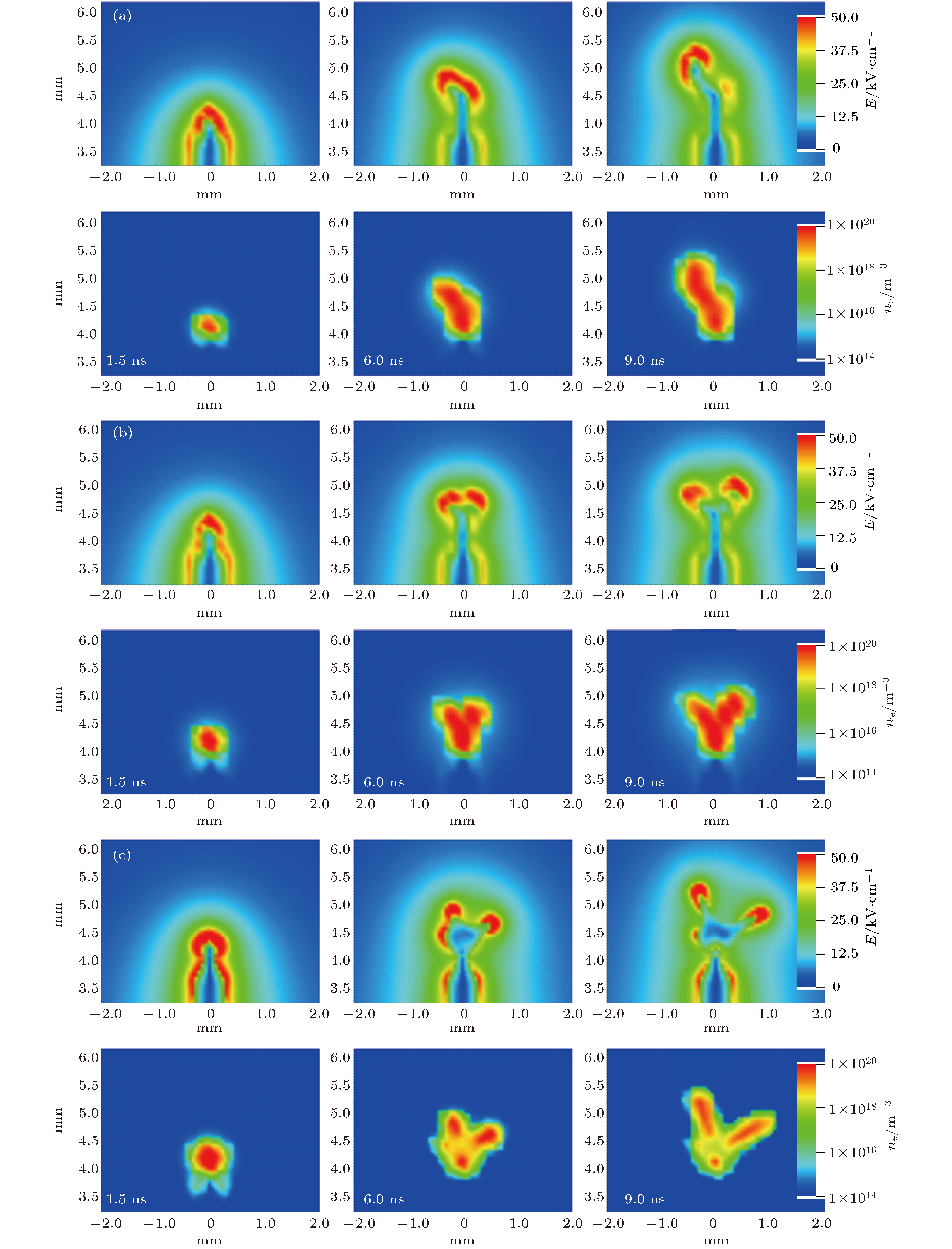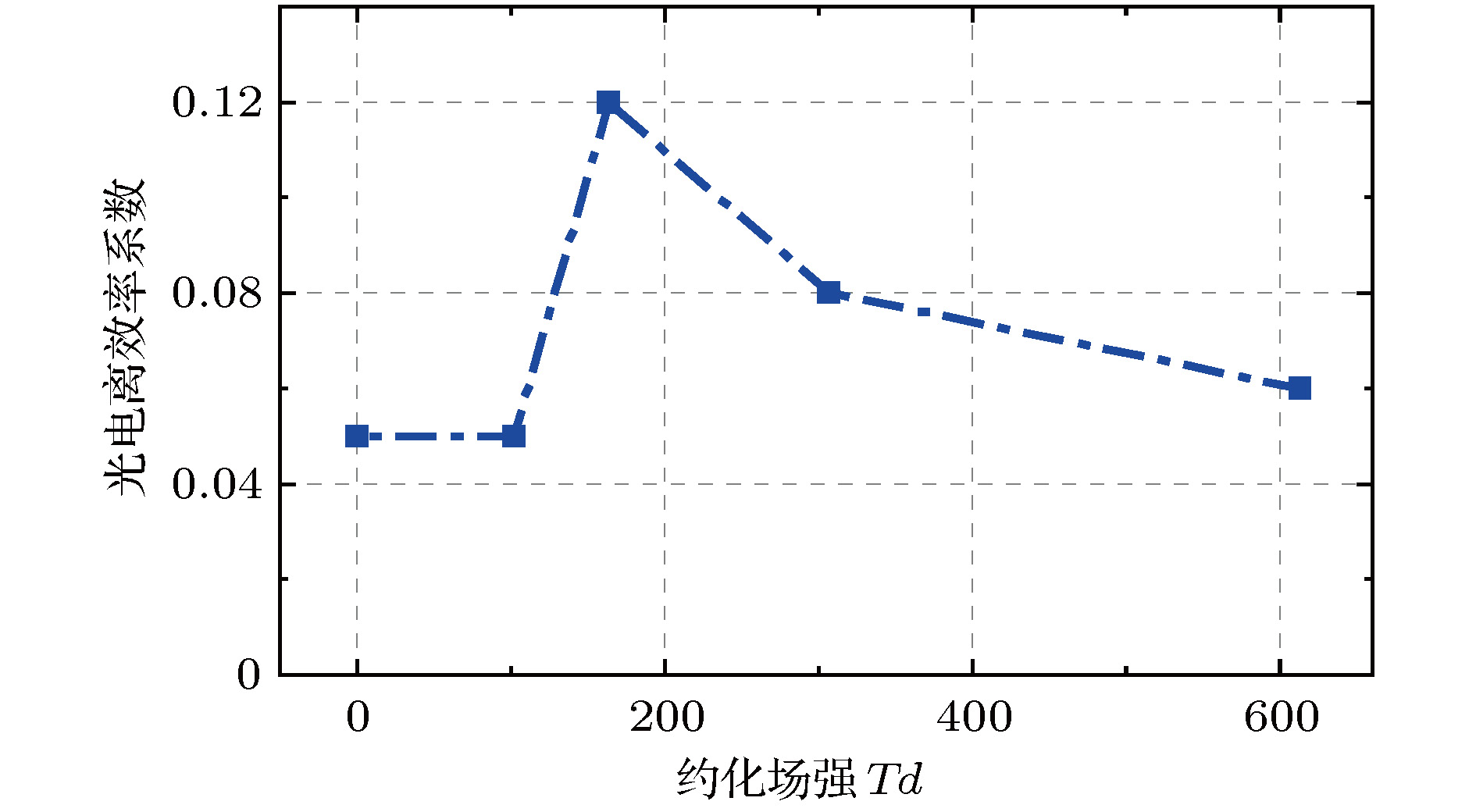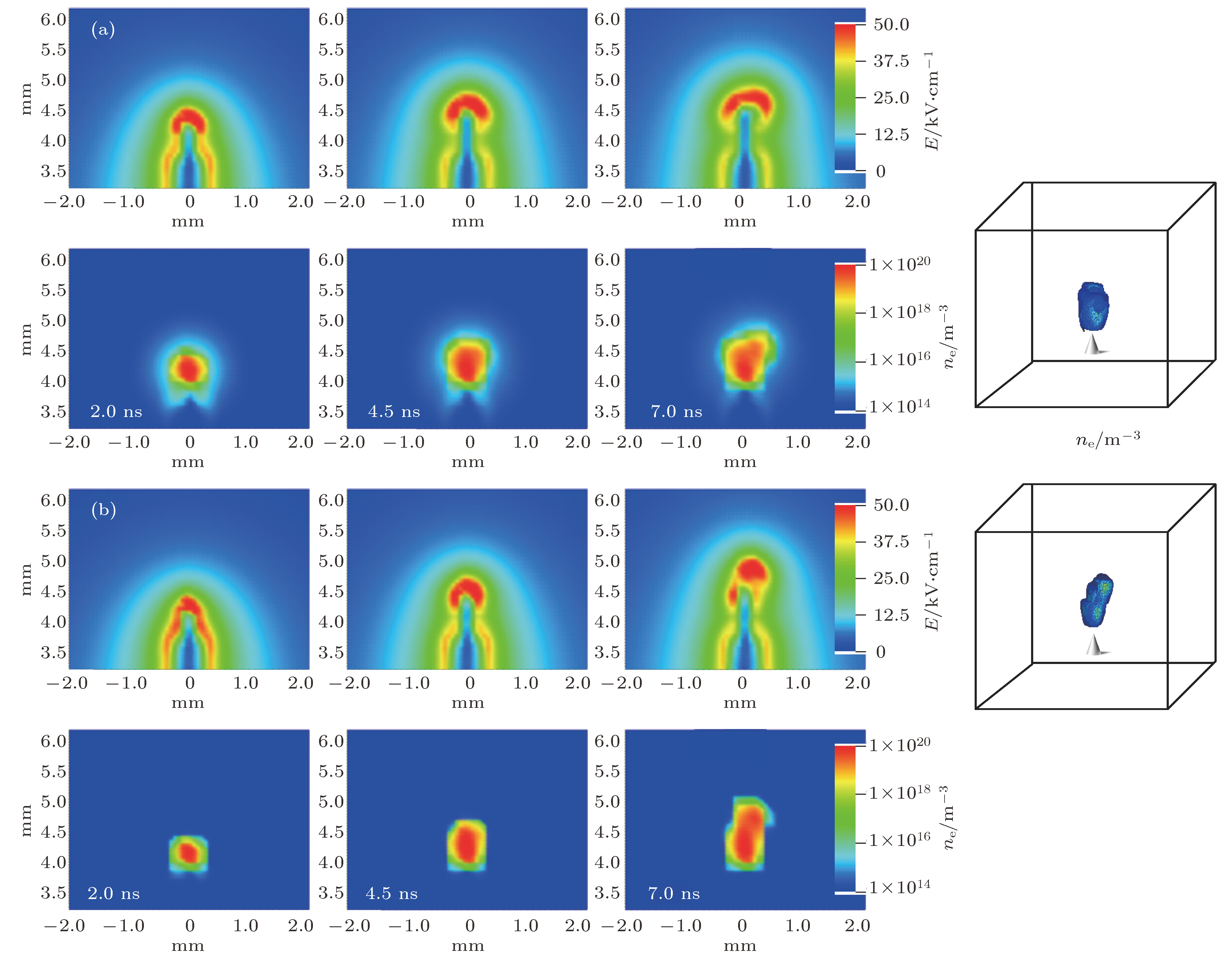-
大气压空气中的流注放电有广泛的理论和应用研究价值, 包括雷电机理、输变电系统空气绝缘理论以及材料表面改性等. 流注是一个快速发展的强电离区域, 在传播过程中存在着一种重要的特点—分支现象. 光电离为正流注发展提供必要的自由电子, 且实验结果表明分支特征与流注头部的光电离速率密切相关. 本文基于新的流注分支判据, 采用了粒子网格单元与蒙特卡罗碰撞相结合(PIC-MCC)的三维放电模型(Pamdi3D)进行数值仿真验证. 为了研究光电离速率对正流注分支的影响, 仿真了毫米尺度间隙针-板电极正流注发展, 系统研究了不同光电离参数的影响. 当减小氮气-氧气比例、光子吸收截面或光电离效率系数后, 流注均更早地出现分支现象. 这些计算结果表明大气压空气中流注头部光电离速率的降低将导致其发生分支的概率更高.Streamer is a strong ionizing region which advances very quickly in gases, liquids and solids. Streamer is a low-temperature plasma, which produces a variety of chemically reactive substances efficiently. So, streamer discharge has been widely adopted in industry. Furthermore, streamer is the initial stage of electric breakdown in long air gap. Studying the streamer discharge characteristics and its mechanism is the basis of external insulation in power transmission systems.Streamer branching is a significant characteristic during its development. Lichtenberg figure is the first clear recording of the filamentary structure of streamers. One of acceptable explanations is that the random fluctuations of the electron density ahead of streamer trigger branching. Furthermore, photoionization provides the necessary free electrons for the development of positive streamers. The experimental results show that the branching characteristics are closely related to the photoionization rate in streamer head. The streamer shows higher possibility of branching if the photoionization rate decreases. Since previous experiment is indirect evidence of this deduction, we turn to numerical models to study the influence of photoionization rates on positive streamer branching in atmospheric air. A three-dimensional particle-in-cell model with Monte Carlo collision (PIC-MCC) scheme called Pamdi3D (Teunissen J, Ebert U 2016 Plasma Sources Sci. Technol. 25 044005) is employed in this paper. The development and branching of positive streamersin a millimeter-scale needle-plane gap are simulated at atmospheric pressure. Different streamer branching behaviors are investigated by artificially changing the nitrogen-oxygen ratio, the absorption cross section of oxygen, and the photoionization efficiency coefficient.The effects of different photoionization parameters are systematically studied. When the nitrogen-oxygen ratio, photon absorption cross section or photoionization efficiency coefficient are reduced, the streamer branching occurs earlier in three cases after reducing the photoionization rate. These results imply that the streamer shows higher possibility of branching if the photoionization rate decreases. When the streamer propagates in a non-uniform electric field region and the photoionization rate decreases to a certain value, it is believed that the seed electron distribution is more susceptible to random fluctuations. It will lead to instability in the space charge layer of streamer, thus causing the streamer to branch. Hence it is proposed that streamer branch will be triggered more easily if the photoionization rate in the streamer head decreases, in the case without considering other seed electron sources.
-
Keywords:
- streamer discharge /
- branching /
- photoionization /
- PIC-MCC /
- atmospheric pressure plasma
[1] Chang J, Lawless P A, Yamamoto T 1991 Plasma Sci. IEEE Trans. 19 1152
 Google Scholar
Google Scholar
[2] Shao T, Wang R, Zhang C, Yan P 2016 High Voltage 3 14
 Google Scholar
Google Scholar
[3] Gallimberti I, Bacchiega G, Bondiou-Clergerie A, Lalande P 2002 Compt. Rendus Phys. 3 1335
 Google Scholar
Google Scholar
[4] 李元, 穆海宝, 邓军波, 张冠军, 王曙鸿 2013 62 124703
 Google Scholar
Google Scholar
Li Y, Mu H B, Deng J B, Zhang G J, Wang S H 2013 Acta Phys. Sin. 62 124703
 Google Scholar
Google Scholar
[5] Pasko V P, Stanley M A, Mathews J D, Inan U S, Wood T G 2002 Nature 416 152
 Google Scholar
Google Scholar
[6] Raizer Y P 1991 Gas Discharge Physics (Berlin: Springer-Verlag) pp334−337
[7] Nijdam S, Takahashi E, Teunissen J, Ebert U 2014 New J. Phys. 16 103038
 Google Scholar
Google Scholar
[8] Pancheshnyi S 2005 Plasma Sources Sci. Technol. 14 645
 Google Scholar
Google Scholar
[9] Nijdam S, Wormeester G, van Veldhuizen E M, Ebert U 2011 J. Phys. D: Appl. Phys. 44 455201
 Google Scholar
Google Scholar
[10] Liu N, Pasko V P 2004 J. Geophys. Res.: Space Phys. 109 A4
 Google Scholar
Google Scholar
[11] Zhelezniak M B, Mnatsakanian A K, Sizykh S V 1982 High Temperat. Sci. 20 423
[12] Chen S, Wang F, Sun Q, Zeng R 2018 IEEE Trans. Dielectr. Electr. Insulat. 25 1128
 Google Scholar
Google Scholar
[13] Nasser E, Loeb L B 1963 J. Appl. Phys. 34 3340
 Google Scholar
Google Scholar
[14] van Veldhuizen E M, Rutgers W R 2002 J. Phys. D: Appl. Phys. 35 2169
 Google Scholar
Google Scholar
[15] Chen S, Zeng R, Zhuang C 2013 J. Phys. D: Appl. Phys. 46 375203
 Google Scholar
Google Scholar
[16] Zeng R, Chen S 2013 J. Phys. D: Appl. Phys. 46 485201
 Google Scholar
Google Scholar
[17] Luque A, Ebert U 2011 Phys. Rev. E 84 046411
 Google Scholar
Google Scholar
[18] Chen S, Wang F, Sun Q, Zeng R 2018 IEEE Trans. Dielectr. Electr. Insulat. 25 2112
 Google Scholar
Google Scholar
[19] Ono R, Oda T 2003 J. Phys. D: Appl. Phys. 36 1952
 Google Scholar
Google Scholar
[20] Briels T M P, van Veldhuizen E M, Ebert U 2008 J. Phys. D: Appl. Phys. 41 234008
 Google Scholar
Google Scholar
[21] Heijmans L C J, Nijdam S, van Veldhuizen E M, Ebert U 2013 Europhys. Lett. 103 25002
 Google Scholar
Google Scholar
[22] Papageorgiou L, Metaxas A C, Georghiou G E 2011 IEEE Trans. Plasma Sci. 39 2224
 Google Scholar
Google Scholar
[23] Arrayás M, Fontelos M A, Kindelán U 2012 Phys. Rev. E 86 066407
 Google Scholar
Google Scholar
[24] Xiong Z, Kushner M J 2014 Plasma Sources Sci. Technol. 23 065041
 Google Scholar
Google Scholar
[25] Zhuang C, Huang M, Zeng R 2018 Commun. Computat. Phys. 24 1259
 Google Scholar
Google Scholar
[26] Chanrion O, Neubert T 2008 J. Computat. Phys. 227 7222
 Google Scholar
Google Scholar
[27] Teunissen J, Ebert U 2014 J. Computat. Phys. 259 318
 Google Scholar
Google Scholar
[28] 孙安邦, 李晗蔚, 许鹏, 张冠军 2017 66 195101
 Google Scholar
Google Scholar
Sun A B, Li H W, Xu P, Zhang G J 2017 Acta Phys. Sin. 66 195101
 Google Scholar
Google Scholar
[29] 李晗蔚, 孙安邦, 张幸, 姚聪伟, 常正实, 张冠军 2018 67 045101
 Google Scholar
Google Scholar
Li H W, Sun A B, Zhang X, Yao C W, Chang Z S, Zhang G J 2018 Acta Phys. Sin. 67 045101
 Google Scholar
Google Scholar
[30] Teunissen J, Ebert U 2016 Plasma Sources Sci. Technol. 25 044005
 Google Scholar
Google Scholar
[31] Penney G W, Hummert G T 1970 J. Appl. Phys. 41 572
 Google Scholar
Google Scholar
-
图 5 不同氧气吸收光子电离截面下流注发展 (a) χmin = 0.0035 Torr–1·cm–1; (b) χmin = 0.7 Torr–1·cm–1
Fig. 5. Electron density and electric field in simulated region at different moments. It shows the comparison of streamerbranching results for different absorption cross sections: (a) χmin = 0.0035 Torr–1·cm–1; (b) χmin = 0.7 Torr–1·cm–1.
图 7 不同光电离效率系数下流注发展仿真结果对比 (a) 2
$P{I_{{\rm{eff}}}}$ ; (b) 0.1$P{I_{{\rm{eff}}}}$ Fig. 7. Electron density and electric field in simulated region at different moments. It shows the comparison of streamer branching results for different photoionization efficiency coefficient: (a) 2
$P{I_{{\rm{eff}}}}$ ; (b) 0.1$P{I_{{\rm{eff}}}}$ . -
[1] Chang J, Lawless P A, Yamamoto T 1991 Plasma Sci. IEEE Trans. 19 1152
 Google Scholar
Google Scholar
[2] Shao T, Wang R, Zhang C, Yan P 2016 High Voltage 3 14
 Google Scholar
Google Scholar
[3] Gallimberti I, Bacchiega G, Bondiou-Clergerie A, Lalande P 2002 Compt. Rendus Phys. 3 1335
 Google Scholar
Google Scholar
[4] 李元, 穆海宝, 邓军波, 张冠军, 王曙鸿 2013 62 124703
 Google Scholar
Google Scholar
Li Y, Mu H B, Deng J B, Zhang G J, Wang S H 2013 Acta Phys. Sin. 62 124703
 Google Scholar
Google Scholar
[5] Pasko V P, Stanley M A, Mathews J D, Inan U S, Wood T G 2002 Nature 416 152
 Google Scholar
Google Scholar
[6] Raizer Y P 1991 Gas Discharge Physics (Berlin: Springer-Verlag) pp334−337
[7] Nijdam S, Takahashi E, Teunissen J, Ebert U 2014 New J. Phys. 16 103038
 Google Scholar
Google Scholar
[8] Pancheshnyi S 2005 Plasma Sources Sci. Technol. 14 645
 Google Scholar
Google Scholar
[9] Nijdam S, Wormeester G, van Veldhuizen E M, Ebert U 2011 J. Phys. D: Appl. Phys. 44 455201
 Google Scholar
Google Scholar
[10] Liu N, Pasko V P 2004 J. Geophys. Res.: Space Phys. 109 A4
 Google Scholar
Google Scholar
[11] Zhelezniak M B, Mnatsakanian A K, Sizykh S V 1982 High Temperat. Sci. 20 423
[12] Chen S, Wang F, Sun Q, Zeng R 2018 IEEE Trans. Dielectr. Electr. Insulat. 25 1128
 Google Scholar
Google Scholar
[13] Nasser E, Loeb L B 1963 J. Appl. Phys. 34 3340
 Google Scholar
Google Scholar
[14] van Veldhuizen E M, Rutgers W R 2002 J. Phys. D: Appl. Phys. 35 2169
 Google Scholar
Google Scholar
[15] Chen S, Zeng R, Zhuang C 2013 J. Phys. D: Appl. Phys. 46 375203
 Google Scholar
Google Scholar
[16] Zeng R, Chen S 2013 J. Phys. D: Appl. Phys. 46 485201
 Google Scholar
Google Scholar
[17] Luque A, Ebert U 2011 Phys. Rev. E 84 046411
 Google Scholar
Google Scholar
[18] Chen S, Wang F, Sun Q, Zeng R 2018 IEEE Trans. Dielectr. Electr. Insulat. 25 2112
 Google Scholar
Google Scholar
[19] Ono R, Oda T 2003 J. Phys. D: Appl. Phys. 36 1952
 Google Scholar
Google Scholar
[20] Briels T M P, van Veldhuizen E M, Ebert U 2008 J. Phys. D: Appl. Phys. 41 234008
 Google Scholar
Google Scholar
[21] Heijmans L C J, Nijdam S, van Veldhuizen E M, Ebert U 2013 Europhys. Lett. 103 25002
 Google Scholar
Google Scholar
[22] Papageorgiou L, Metaxas A C, Georghiou G E 2011 IEEE Trans. Plasma Sci. 39 2224
 Google Scholar
Google Scholar
[23] Arrayás M, Fontelos M A, Kindelán U 2012 Phys. Rev. E 86 066407
 Google Scholar
Google Scholar
[24] Xiong Z, Kushner M J 2014 Plasma Sources Sci. Technol. 23 065041
 Google Scholar
Google Scholar
[25] Zhuang C, Huang M, Zeng R 2018 Commun. Computat. Phys. 24 1259
 Google Scholar
Google Scholar
[26] Chanrion O, Neubert T 2008 J. Computat. Phys. 227 7222
 Google Scholar
Google Scholar
[27] Teunissen J, Ebert U 2014 J. Computat. Phys. 259 318
 Google Scholar
Google Scholar
[28] 孙安邦, 李晗蔚, 许鹏, 张冠军 2017 66 195101
 Google Scholar
Google Scholar
Sun A B, Li H W, Xu P, Zhang G J 2017 Acta Phys. Sin. 66 195101
 Google Scholar
Google Scholar
[29] 李晗蔚, 孙安邦, 张幸, 姚聪伟, 常正实, 张冠军 2018 67 045101
 Google Scholar
Google Scholar
Li H W, Sun A B, Zhang X, Yao C W, Chang Z S, Zhang G J 2018 Acta Phys. Sin. 67 045101
 Google Scholar
Google Scholar
[30] Teunissen J, Ebert U 2016 Plasma Sources Sci. Technol. 25 044005
 Google Scholar
Google Scholar
[31] Penney G W, Hummert G T 1970 J. Appl. Phys. 41 572
 Google Scholar
Google Scholar
计量
- 文章访问数: 12118
- PDF下载量: 127
- 被引次数: 0














 下载:
下载:










